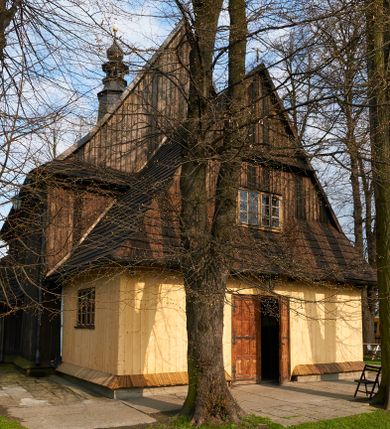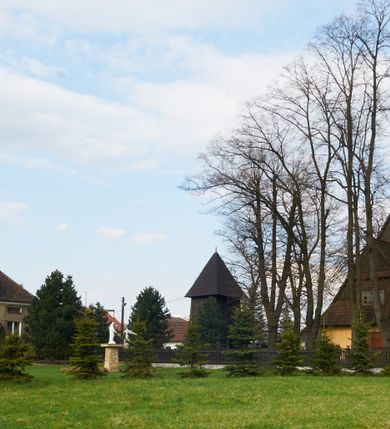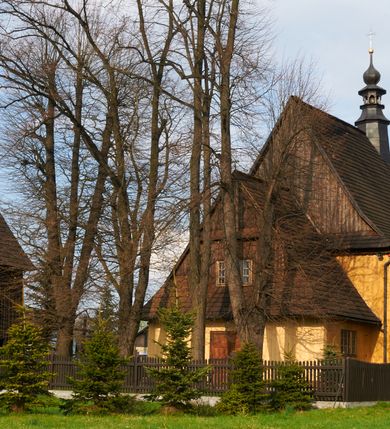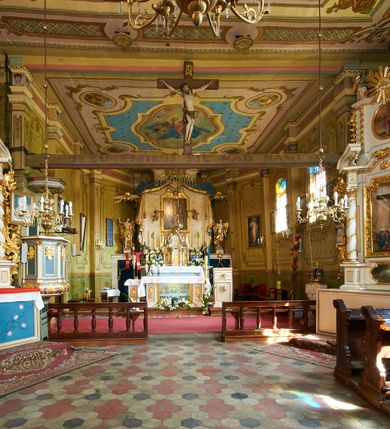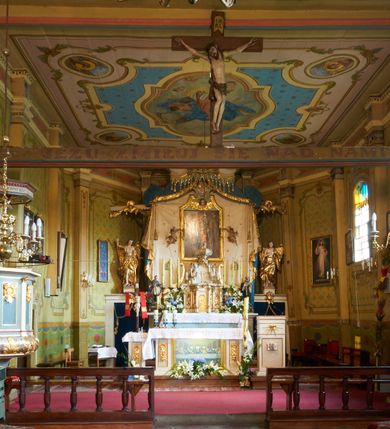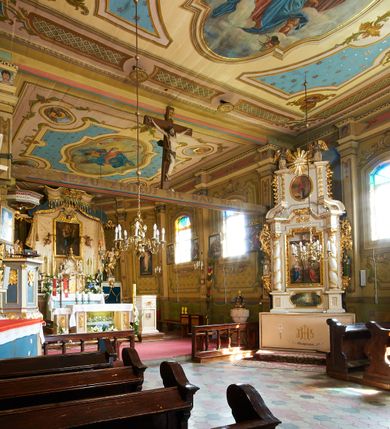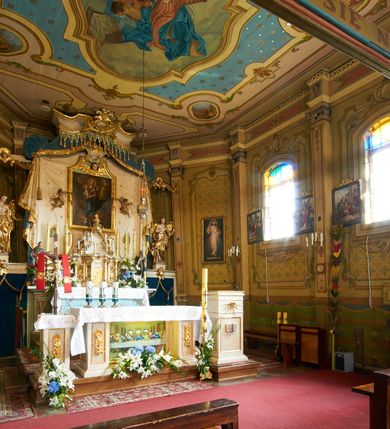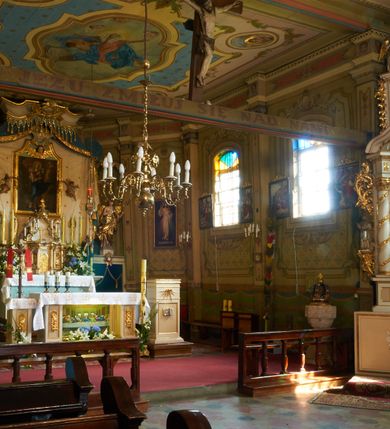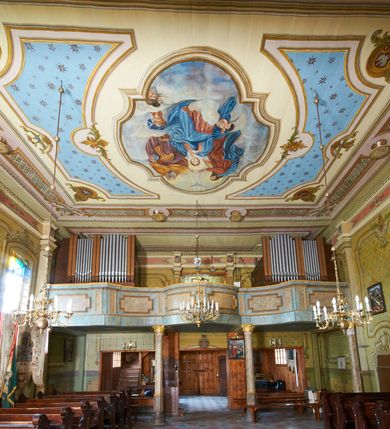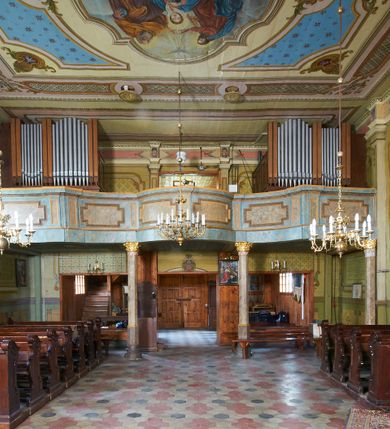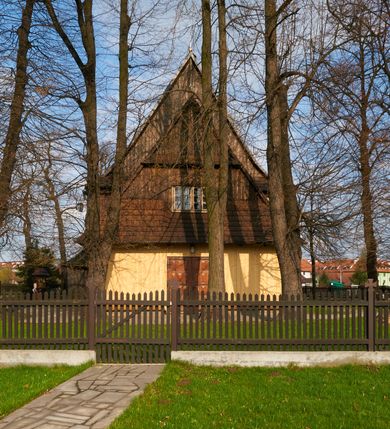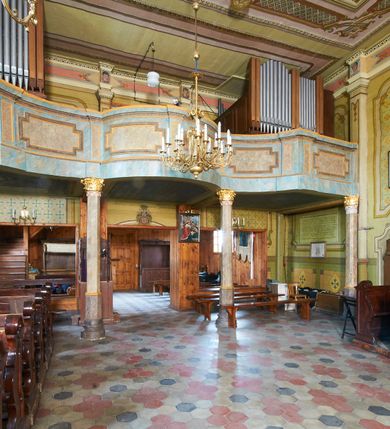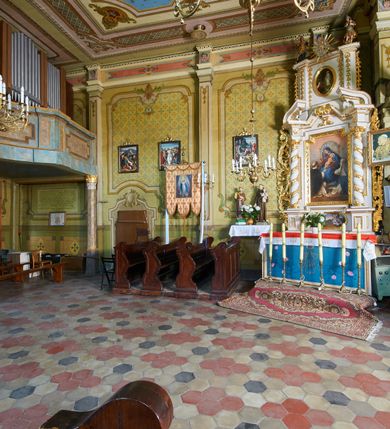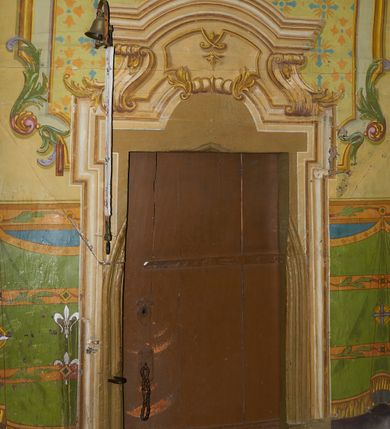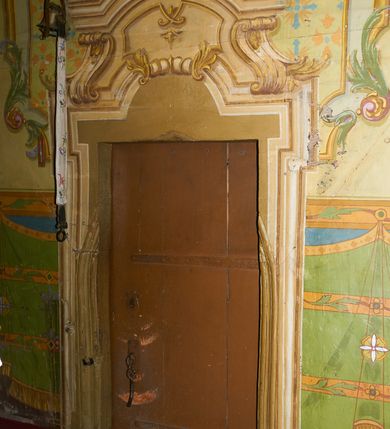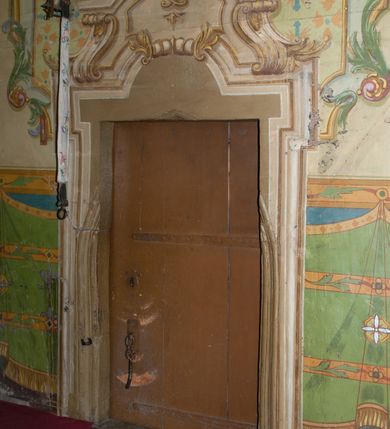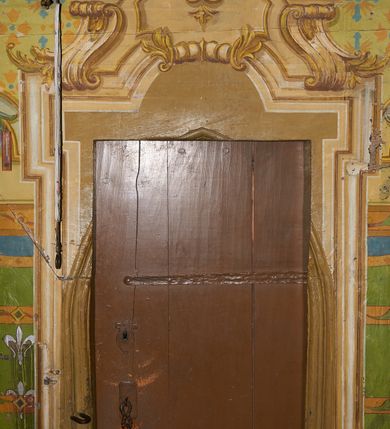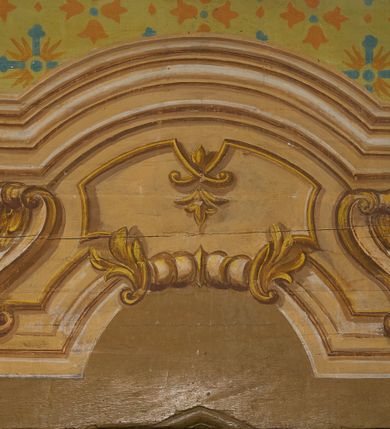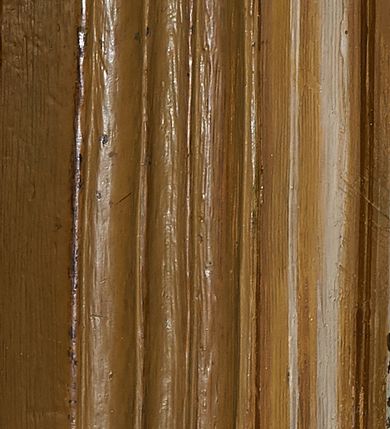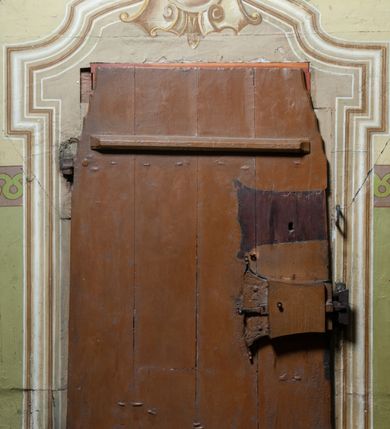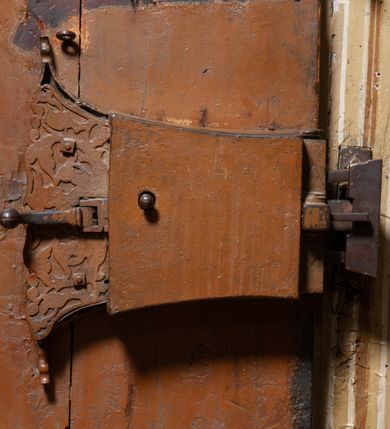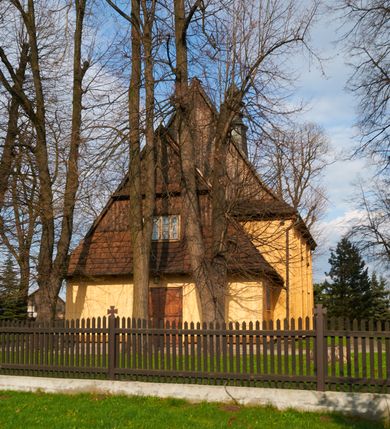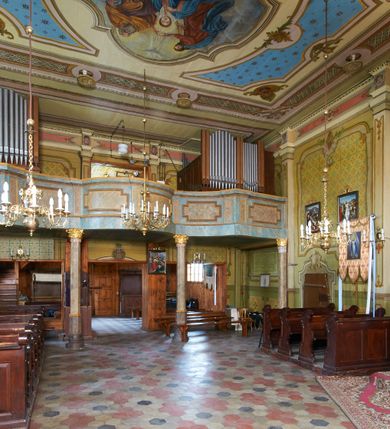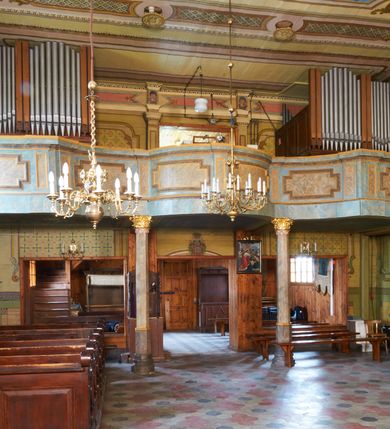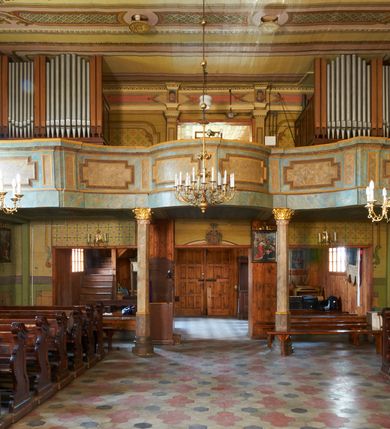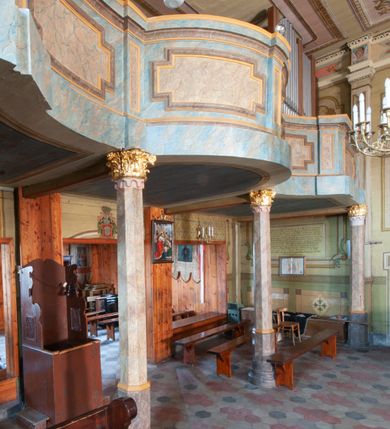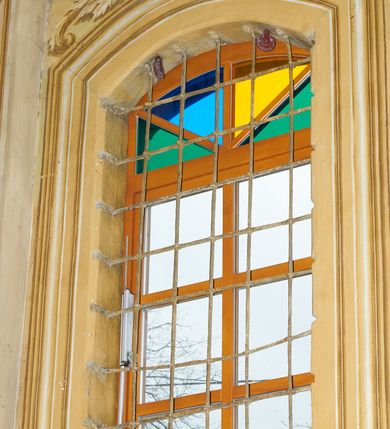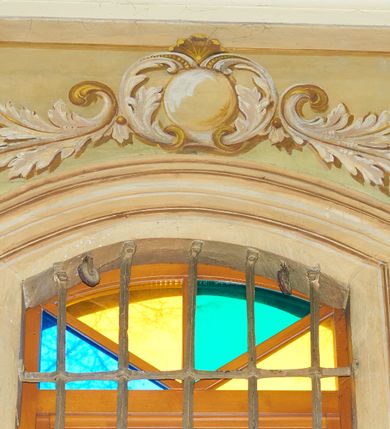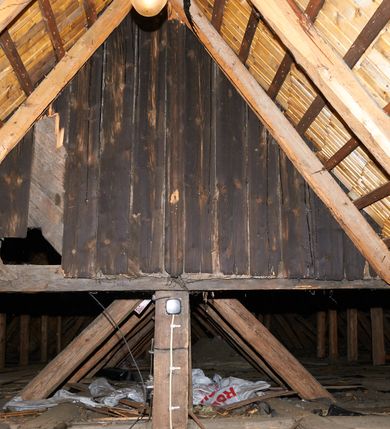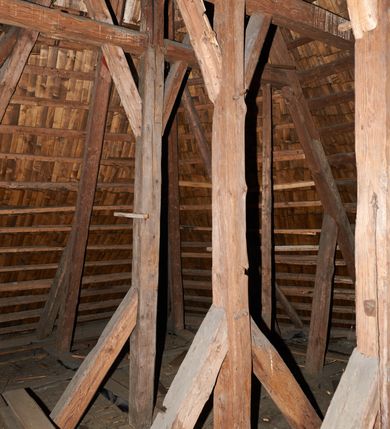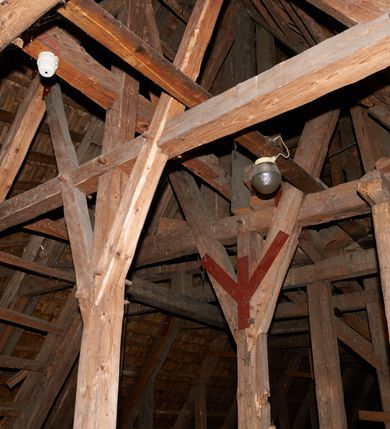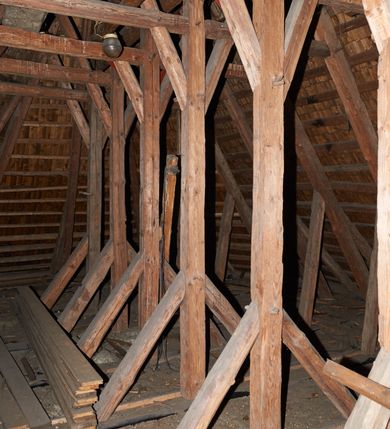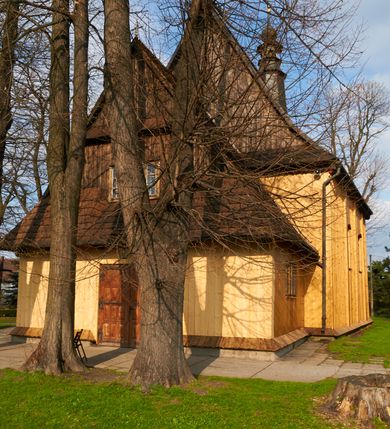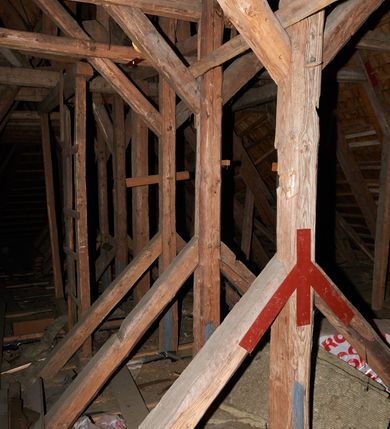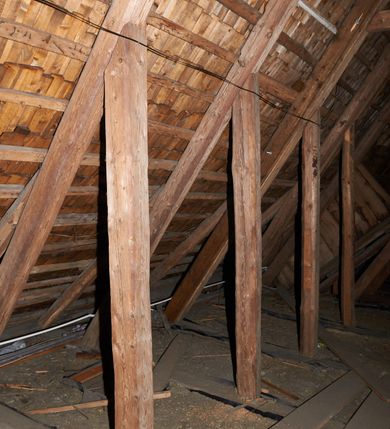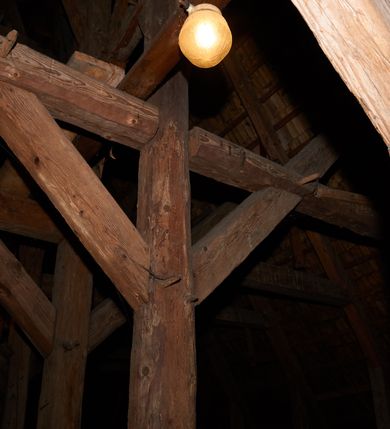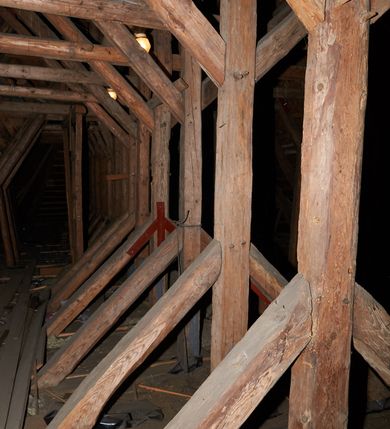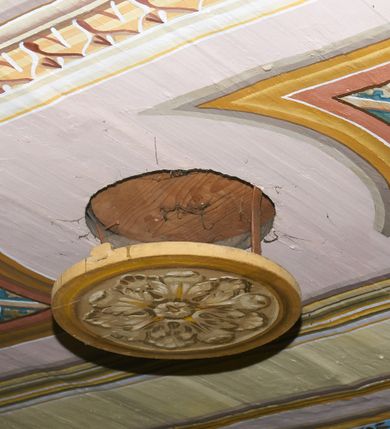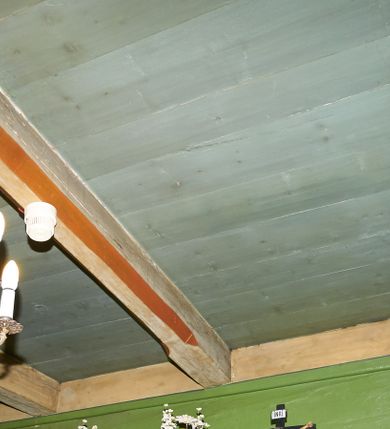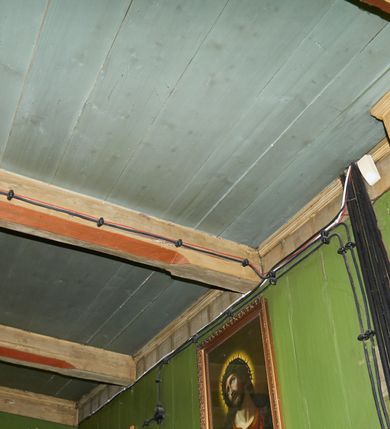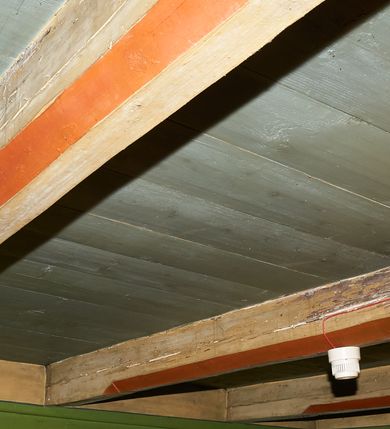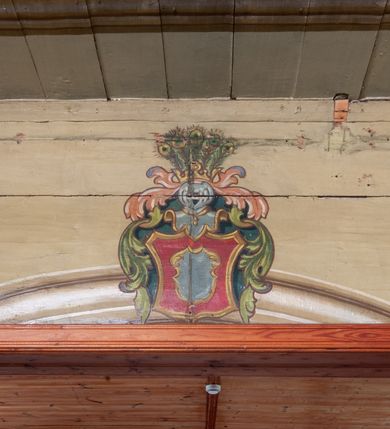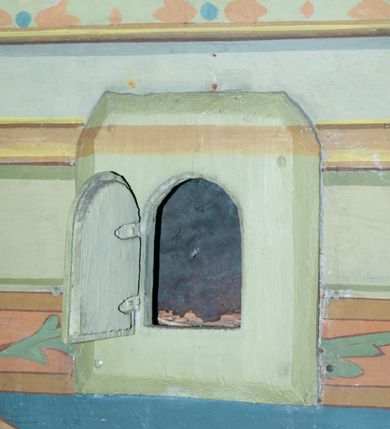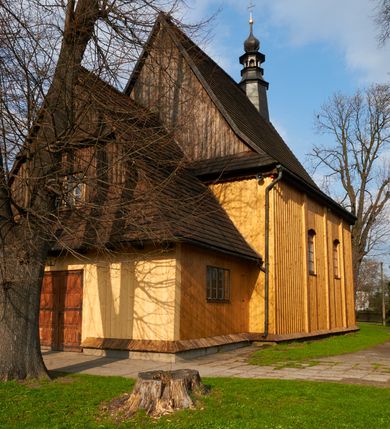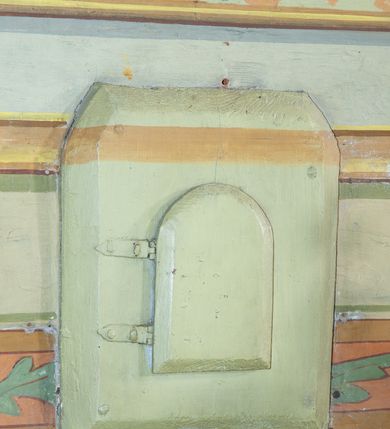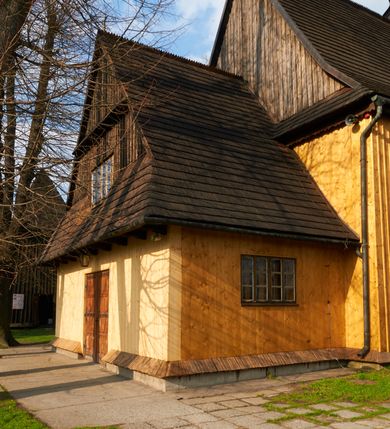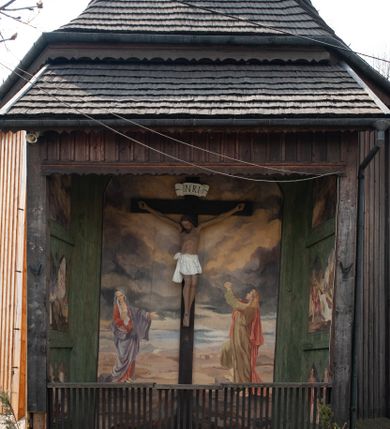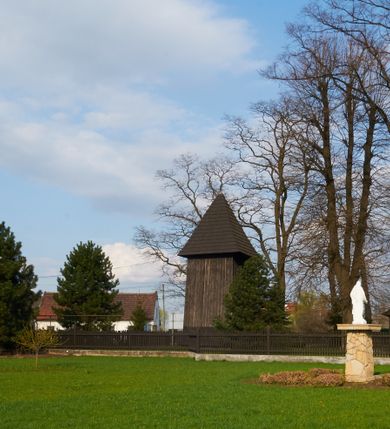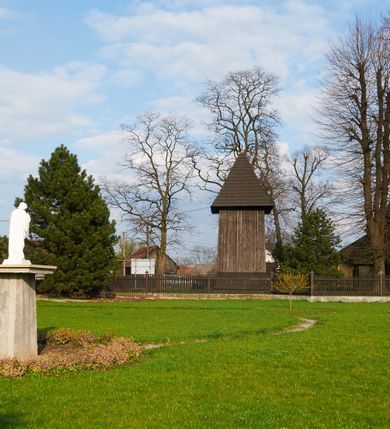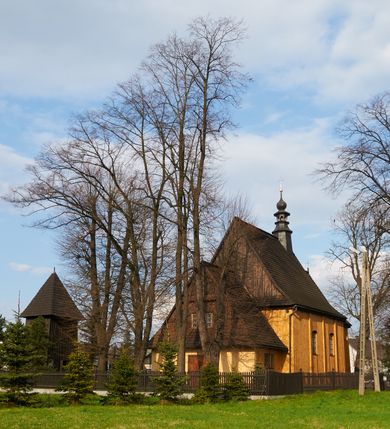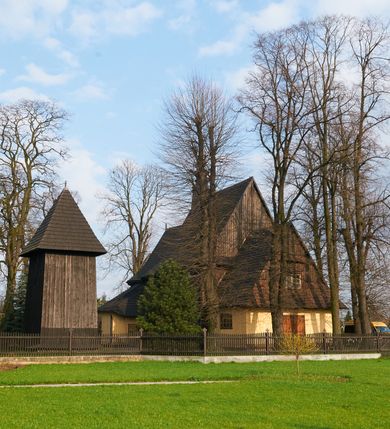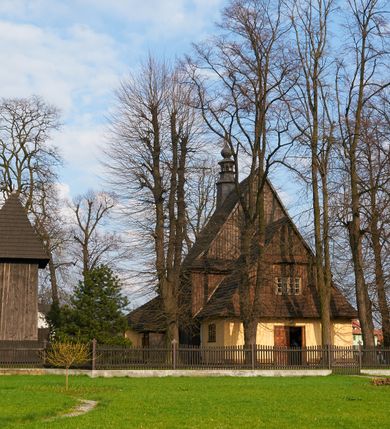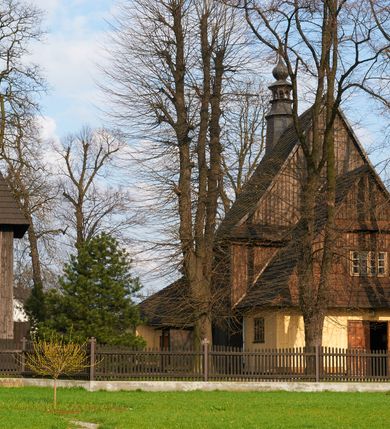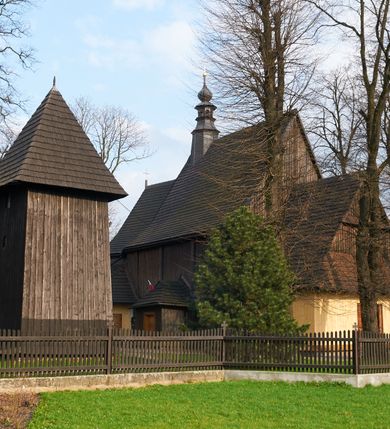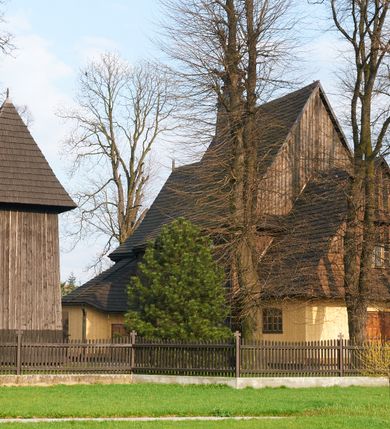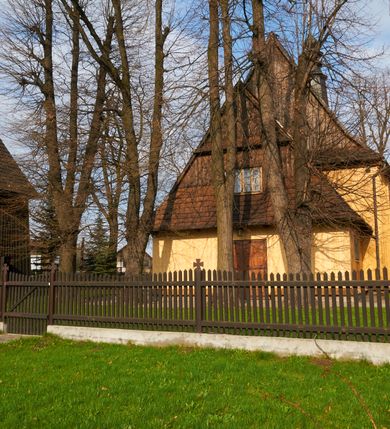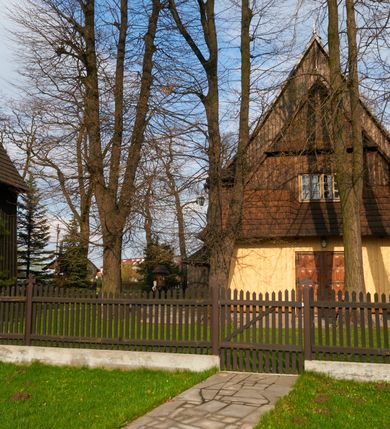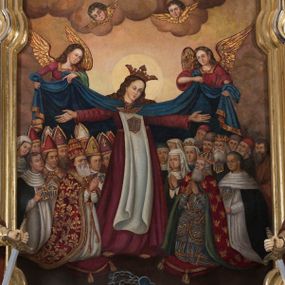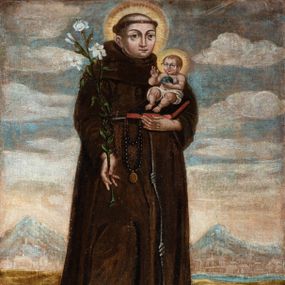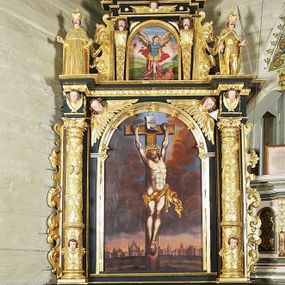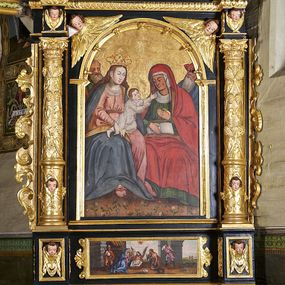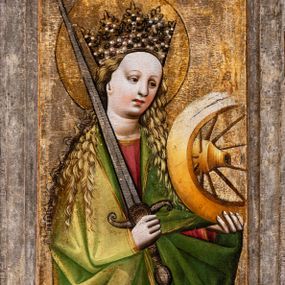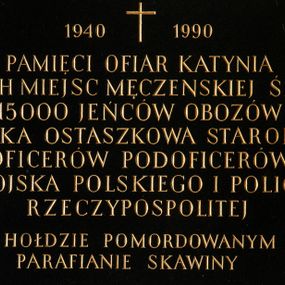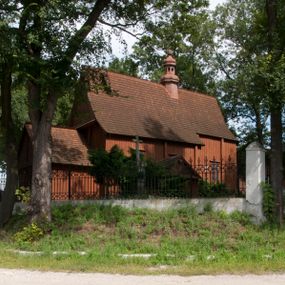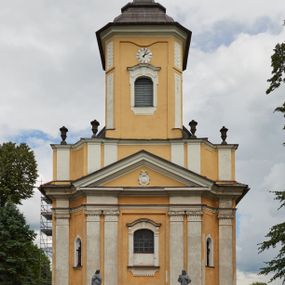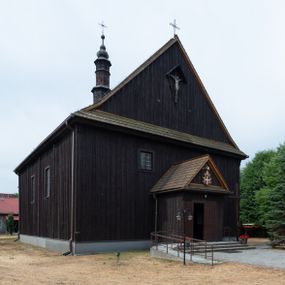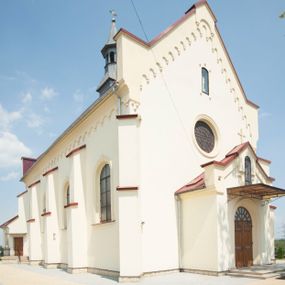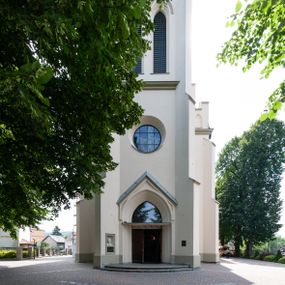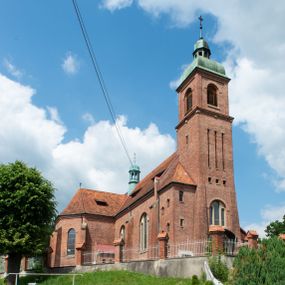
Church of the Assumption of the Blessed Virgin Mary
Identifier
DZIELO/12503
Amount
1
Catalogue note author
Paulina Kluz
History of work
The first parish church came from 1386 and was located in Wola, a village in the Griffin dynasty estate, so it is presumed that it was founded by the then owner of the property, Wierzbięta from Branice. After 1420, the church building was moved to Grabia to the other bank of the Vistula River. The seventeenth-century visitation records mention three altars in the church: the main altar of Our Lady and two side altars, one of which was dedicated to St. Anne. The acts of 1665 also mention a polychrome inside the church.
In 1742, work began on relocating the temple again - to another place in Grabia, a meadow called Gruczyn, where it is still located today. The work was initiated by the then parish priest Jakub Cichoński and Father Wawrzyniec Rempalski, Dean of Proszowice. In the above-mentioned year of relocation, masses were still held in the former church. This proves that the temple gained almost a completely new form and new furnishings, and only a part of the building material from the old church was used for its construction. The new church was consecrated on 14 September 1749 by Bishop Michał Kunicki. The created building obtained mainly new architectural and sculptural furnishings. In the visitation acts of 1747, five altars were mentioned, namely the main altar of Our Lady and the side altars of St. Joseph, St. John Cantius (on the right) and St. Anne and the St Sa.lvator (on the left). In the temple, there also was a pulpit and an organ loft. The church was repainted in 1754 (such a date was once painted on the rainbow). In 1835-1836, the temple was repaired. The beams were then pulled up (the base on which the wall rests) and walls were fastened with oak clamps. Three mensas were set in the altars, namely the high altar, St. Joseph's altar and the altar of Transfiguration of Jesus. This proves that there were only three altars in the church at that time, which were the only altars with the invocations indicated. In 1844, the church was repainted again. In 1879, the church floor was repaired: "hard stone floor brought from Rzegocina was used in the nave from the rood screen to almost half of the floor, while the rest was laid with old stones", the oak thresholds were thrown out, and, in their place, turned oak bases were installed under all pillars. In 1885, from parishioners' contributions and at his own expense, parish priest A. Konopiński bought four windows for the south side of the building "with colourful ornaments in oak frames." At the turn of 1899 and 1900, a new shingle roof was installed on the church, while the garret and ridge turret were boarded with planks. In 1907, in the days of parish priest Józef Raźny, the condition of the church was described as bad and a thorough renovation started. Rotten stringpieces were replaced with new oak ones, and concrete-reinforced foundation was laid under them. The church was lined with a cement floor and the rest, which was in good condition, was laid in the sacristy. The church was repainted with oil paints on the inside and outside. The polychromes of the interior with the scenes of the Assumption of the Blessed Virgin Mary in the presbytery and the crowning of the Blessed Virgin Mary in the main nave were made by Jan Talaga from Kraków. "The decorative part of the entire church is attributed to Mr. Michał Tarczatowicz from Bochnia." The pillars supporting the walls of the church were boarded with planks in the form of "prism-shaped pilasters" with chapiters. The cost of the renovation was 6400 Crowns, which were collected from voluntary contributions. In 1911, a new floor was laid out in the loft and an additional doorway was created in the sacristy due to fire concerns. The church was seriously damaged during war operations in 1914: "The roof of the bell tower, the roof of the Church, the organ and the loft, the altar of St. Anthony, the Baroque pulpit, the northern wall of the church, flags, banners, the Gothic lamp, the hanging candle holder, all of it was destroyed and all the windows were smashed. After these events, the parish priest applied makeshift fixes to the roof and fitted glass into the windows. In 1916 "through the k.u. k. Society of Heritage Art, I [parish priest Józef Raźny] managed to obtain a subsidy for the restoration of the Church in the amount of 3100 Crowns, for which I covered the larger portion of the church's roof with new shingles, inserted a new northern wall of the church at the former altar of St. Anthony, repaired the truss in the attic, filled holes in other walls with new flat logs, and put a concrete foundation in place of the oaken sill plate that had been crushed by cannonballs on the southern and western side." Subsequently, the pulpit was renovated and the organ loft in the church was renovated the following year. In 1919, a pump organ was bought instead of a pipe organ. In 1929, a new altar of Our Lady of the Rosary with her painting was built in place of the destroyed altar of St. Anthony. In 1937, thanks to the parishioners' contributions, half of the roof was covered with shingles, and the works on the second half of the roof were completed in 1941. In 1947, a fence was built around the church. In 1956, the church was electrified and equipped with new lamps. A year later, a renovation of the church financed by the parishioners' contributions commenced, namely the roof of the sacristy and the northern side of the church were covered with shingles. Carpenters from Niedźwiedź were brought in for that purpose. The decayed ridge turret was replaced with a new one, covered with sheet metal. The next stage of the works in 1958 was the laying of new foundations for the church and covering of the underpinning with shingles, which was conducted by highlanders from Niedźwiedź. Jan Kalisz from Brzegi painted the church from the outside. Renovation of the polychrome and the entire interior was carried out a year later by Józef Nawałka from Kraków together with five assistants. During the ministry of the parish priest Józef Masłowski, namely in the years 1979-1986, the church was extended by a porch on the western side, the entire church was boarded with new planks on the outside, and all the doors were replaced. In April 1989, Różecki from Kętek painted the Garden of Gethsemane on the eastern, outer wall of the chancel. A year later, with the help of the parishioners, the church, its external facades and the roof were secured with varnish. In 1997, Dorota Wąchalska performed polychrome conservation works. Works aimed at strengthening the roof structure were also in progress. In 2000, the ridge turret was renovated and a new cross was mounted on its top.
Abstract
The church in Grab was built in 1742 using building blocks from the previous church from the 15th century. It was renovated many times and partly rebuilt. It belongs to a group of wooden temples in Lesser Poland, built in the 18th century, where the traditional scheme of a towerless church was used, but with baroque structural and decorative characteristics.
Other works from this place
Other works from this year
Similar works
How to cite?
Paulina Kluz, "Church of the Assumption of the Blessed Virgin Mary", [in:] "The Sacred Lesser Poland Heritage", 2026, source: https://sdm.upjp2.edu.pl/en/works/church-of-the-assumption-of-the-blessed-virgin-mary-1
